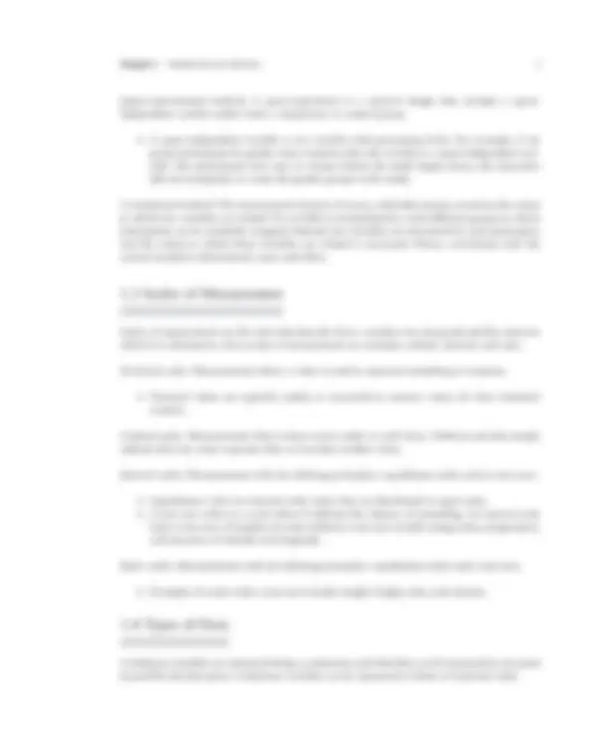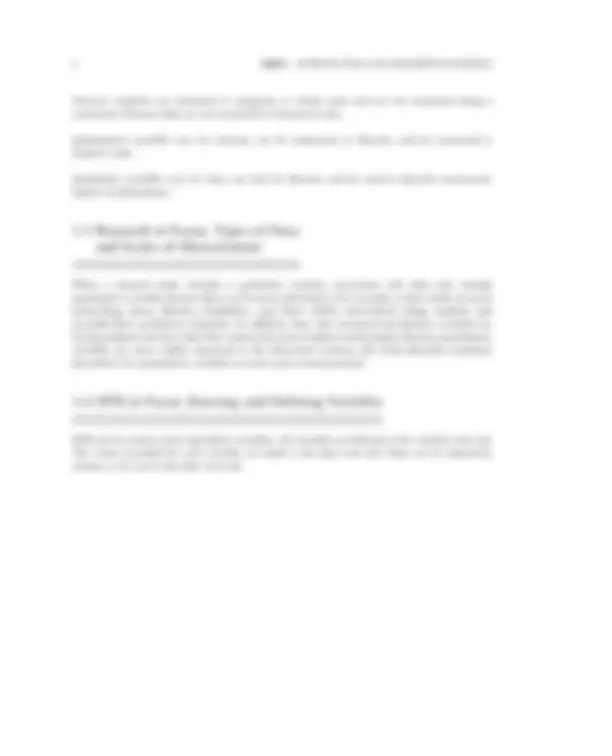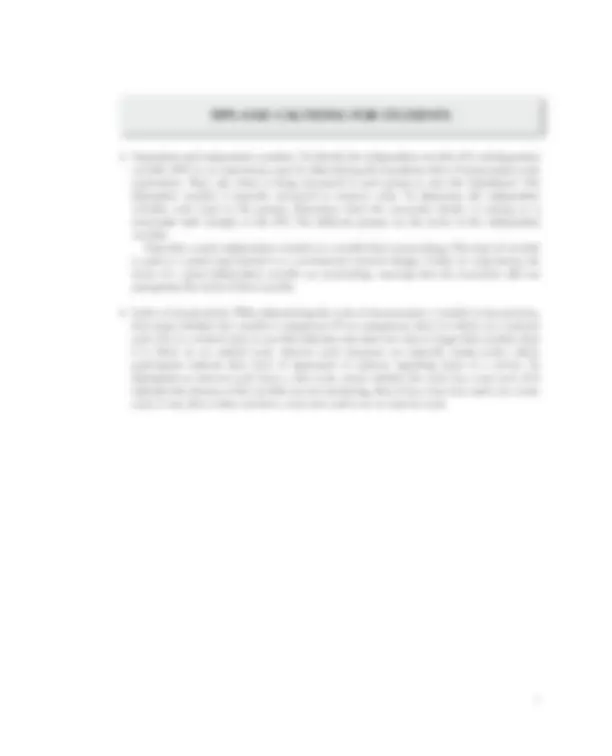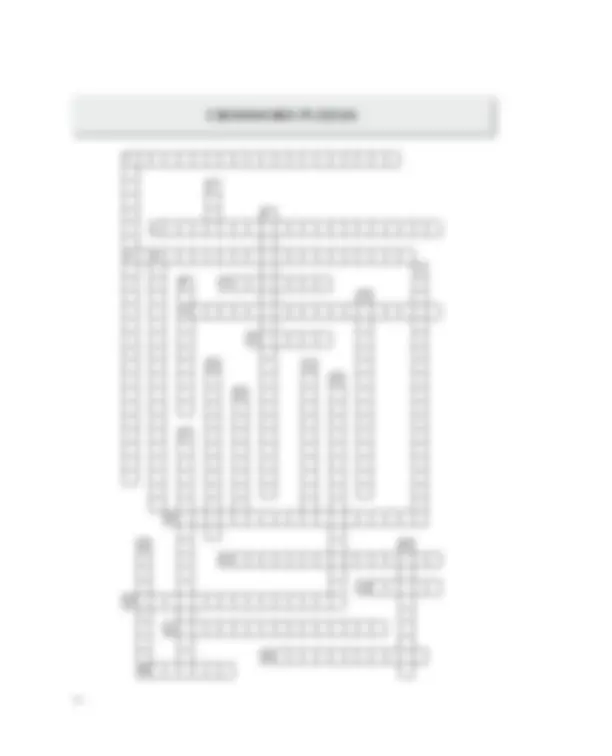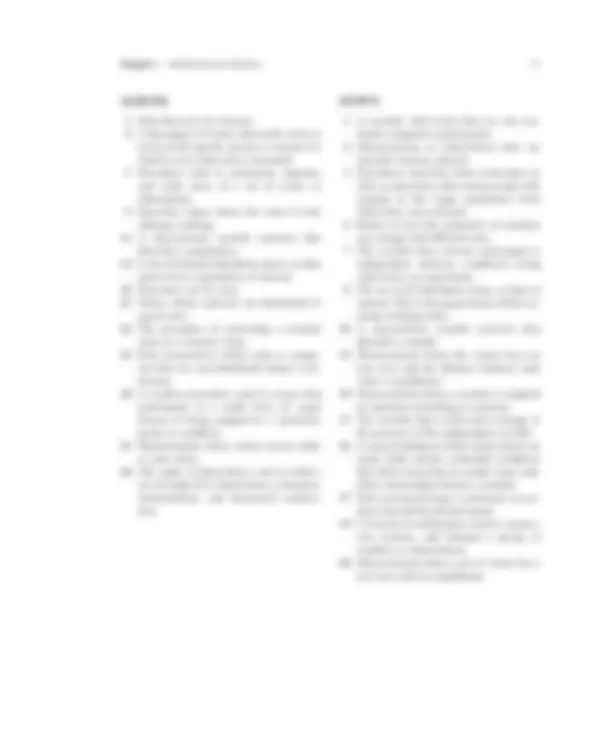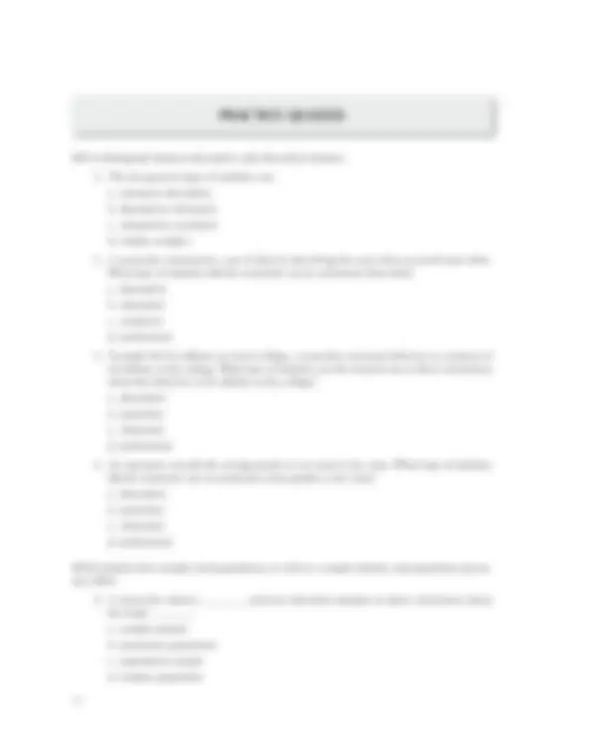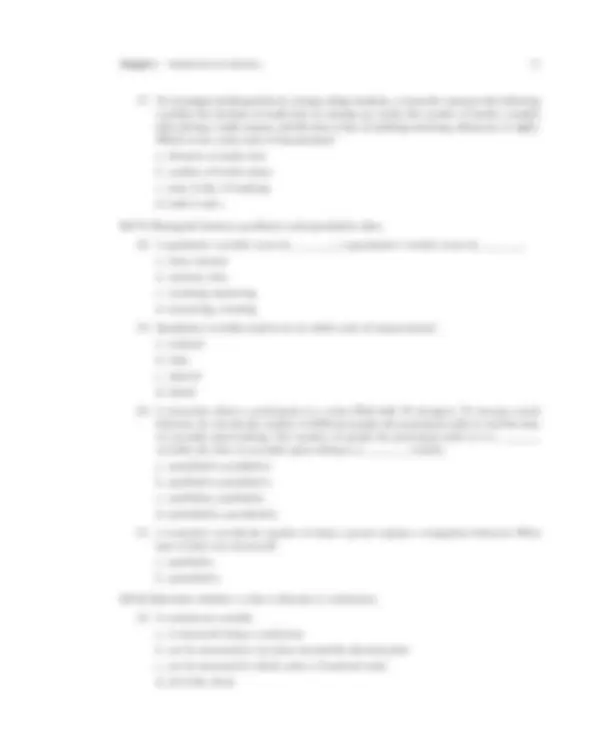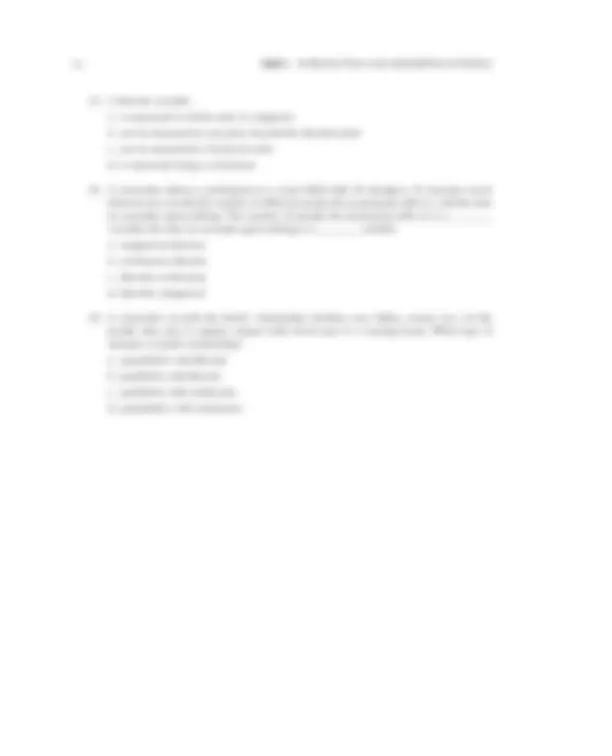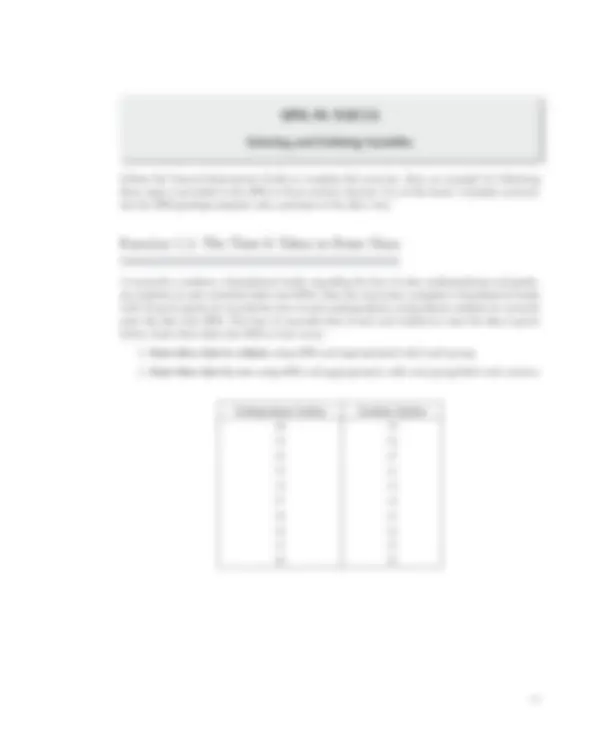Download Introduction to Statistics: A Comprehensive Guide with Practice Quizzes and more Lecture notes Statistics in PDF only on Docsity!
3
Introduction
to Statistics
LEARNING OBJECTIVES
After reading this chapter, you should be able to:
- Distinguish between descriptive and inferential statistics.
- Explain how samples and populations, as well as a sample statistic and population parameter, differ.
- Describe three research methods commonly used in behavioral science.
- State the four scales of measurement and provide an example for each.
- Distinguish between qualitative and quantitative data.
- Determine whether a value is discrete or continuous.
- Enter data into SPSS by placing each group in separate columns and each group in a single column (coding is required).
4
1.1 Descriptive and Inferential Statistics
Statistics: A branch of mathematics used to summarize, analyze, and interpret a group of numbers or observations. Two types of statistics are descriptive statistics and inferential statistics.
- Descriptive statistics: Procedures used to summarize, organize, and make sense of a set of scores or observations. { { Data are multiple measurements typically numeric in form; a single observation is referred to as a datum or raw score. { { Descriptive statistics can be presented as a graphical, tabular, or summary display.
- Inferential statistics: Procedures used that allow researchers to infer or generalize observa- tions made with samples to the larger population from which they were selected. { { Population parameter: A characteristic, usually numeric, that describes a population. { { Sample statistic: A characteristic, usually numeric, that describes a sample.
1.2 Statistics in Research
Experimental method: An experiment is any study that controls the conditions under which observations are made to isolate cause-and-effect relationships between two variables. To conduct an experiment, we must meet three requirements: randomization, manipulation, and comparison.
- Randomization consists of using random assignment to ensure that all participants in the study have an equal probability of being assigned to a group.
- Manipulation consists of creating the levels of the independent variable. Each level is a group—hence, manipulation allows us to create groups to which the participants will be randomly assigned.
- Comparison involves the use of a control group that does not receive the manipulation believed to cause changes in a dependent variable. This allows us to compare the control group to the group that received the manipulation, thereby allowing us to determine whether the manipulation is actually causing changes in the dependent variable. Independent variable (IV): The variable that is manipulated in an experiment. By manipulating the IV, we create the different groups in a study. Dependent variable (DV): The variable that is measured in each group or level of the independent variable_._ The dependent variable must be operationally defined , meaning that it is defined by the specific process or manner by which it was observed or measured.
CHAPTER OUTLINE
6 PART I INTRODUCTION AND DESCRIPTIVE STATISTICS Discrete variables are measured in categories or whole units and are not measured along a continuum. Discrete data are not measured in fractional units. Quantitative variables vary by amount, can be continuous or discrete, and are measured in numeric units. Qualitative variables vary by class, can only be discrete, and are used to describe nonnumeric aspects of phenomena.
1.5 Research in Focus: Types of Data
and Scales of Measurement
When a research study includes a qualitative variable, researchers will often also include quantitative variables because these can be more informative. For example, in their study on social networking, Jones, Blackey, Fitzgibbon, and Chew (2010) interviewed college students and recorded their qualitative responses. In addition, they also measured quantitative variables by having students rate how often they used certain social software technologies. Because quantitative variables are more widely measured in the behavioral sciences, this book describes statistical procedures for quantitative variables on each scale of measurement.
1.6 SPSS in Focus: Entering and Defining Variables
SPSS can be used to enter and define variables. All variables are defined in the variable view tab. The values recorded for each vari able are listed in the data view tab. Data can be entered by column or by row in the data view tab.
7
- Dependent and independent variables: To identify the independent variable (IV) and dependent variable (DV) in an experiment, start by determining the hypothesis that is being tested in the experiment. Then ask, what is being measured in each group to test this hypothesis? The dependent variable is typically measured in numeric units. To determine the independent variable, refer back to the groups. Determine what the researcher thinks is causing or is associated with changes in the DV. The different groups are the levels of the independent variable. Note that a quasi-independent variable is a variable that is preexisting. This type of variable is used in a quasi-experimental or a correlational research design. Unlike an experiment, the levels of a quasi-independent variable are preexisting, meaning that the researcher did not manipulate the levels of that variable.
- Scales of measurement: When determining the scale of measurement a variable is measured on, first assess whether the variable is categorical. If it is categorical, then it is likely on a nominal scale. If it is a ranked value or one that indicates only that one value is larger than another, then it is likely on an ordinal scale. Interval scale measures are typically rating scales, where participants indicate their level of agreement or opinion regarding items in a survey. To distinguish an interval scale from a ratio scale, assess whether the scale has a true zero. If 0 indicates the absence of the variable you are measuring, then it has a true zero and is on a ratio scale; if not, then it does not have a true zero and is on an interval scale.
TIPS AND CAUTIONS FOR STUDENTS
Chapter 1 Introduction to Statistics 9 STATISTICS DESCRIPTIVE STATISTICS DATA RAW SCORE INFERENTIAL STATISTICS POPULATION POPULATION PARAMETER SAMPLE OPERATIONAL DEFINITION SCIENCE INDEPENDENT VARIABLE DEPENDENT VARIABLE QUASI-INDEPENDENT VARIABLE EXPERIMENT RANDOM ASSIGNMENT
SCALES OF MEASUREMENT
NOMINAL SCALE
CODING
ORDINAL SCALE
INTERVAL SCALE
EQUIDISTANT SCALE
TRUE ZERO
RATIO SCALE
QUALITATIVE DATA
QUANTITATIVE DATA
CONTINUOUS DATA
DISCRETE DATA
SAMPLE STATISTIC
DATUM
SCORE
10
CROSSWORD PUZZLES
12
PRACTICE QUIZZES
LO 1: Distinguish between descriptive and inferential statistics.
- The two general types of statistics are: a. summary; descriptive b. descriptive; inferential c. interpretive; analytical d. simple; complex
- A researcher summarizes a set of data by describing the score that occurred most often. What type of statistics did the researcher use to summarize these data? a. descriptive b. inferential c. analytical d. professional
- To study NCAA athletes at a local college, a researcher measures behavior in a portion of all athletes at the college. What type of statistics can the research use to draw conclusions about the behavior of all athletes at the college? a. descriptive b. parameter c. inferential d. professional
- An instructor records the average grade on an exam in her class. What type of statistics did the instructor use to summarize exam grades in her class? a. descriptive b. parameter c. inferential d. professional LO 2: Explain how samples and populations, as well as a sample statistic and population param- eter, differ.
- A researcher selects a ________ and uses inferential statistics to draw conclusions about the larger ________. a. sample; statistic b. parameter; population c. population; sample d. sample; population
Chapter 1 Introduction to Statistics 13
- A professor is interested in studying the attitudes of students in her class. She has all of the students in her class fill out a survey and records their responses. In this example, the professor: a. failed to identify the population of interest b. measured data in the sample of students c. measured data in the population of students d. did not have enough data to draw conclusions about the population of interest
- A characteristic in a population is called a ________, whereas a characteristic in a sample is called a ________. a. population parameter; sample statistic b. sample statistic; population parameter c. sample parameter; population statistic d. population statistic; sample parameter
- Most students selected at random to a sample are women. The characteristic that most of the sample consists of women is an example of a(n): a. population parameter b. sample statistic c. inferential statistic d. statistical anomaly LO 3: Describe three research methods commonly used in behavioral science.
- The research method used to demonstrate that one variable causes changes in a dependent variable is called the: a. experimental method b. quasi-experimental method c. correlational method d. investigative method
- A researcher measures the number of hours spent studying among students living on-campus and off-campus at a local college. In this study, location (on-campus, off- campus) is the ________ and hours spent studying is the ________. a. independent variable; dependent variable b. dependent variable; independent variable c. quasi-independent variable; dependent variable d. dependent variable; quasi-independent variable
Chapter 1 Introduction to Statistics 15
- To investigate studying behavior among college students, a researcher measures the following variables: the duration of study time (in minutes per week), the number of breaks a student takes during a study session, and the time of day of studying (morning, afternoon, or night). Which is not a ratio scale of measurement? a. duration of study time b. number of breaks taken c. time of day of studying d. both b and c LO 5: Distinguish between qualitative and quantitative data.
- A qualitative variable varies by ________; a quantitative variable varies by ________. a. class; amount b. amount; class c. counting; measuring d. measuring; counting
- Qualitative variables tend to be on which scale of measurement? a. nominal b. ratio c. interval d. lateral
- A researcher places a participant in a room filled with 10 strangers. To measure social behavior, he records the number of different people the participant talks to and the time (in seconds) spent talking. The number of people the participant talks to is a ________ variable; the time (in seconds) spent talking is a ________ variable. a. quantitative; qualitative b. qualitative; quantitative c. qualitative; qualitative d. quantitative; quantitative
- A researcher records the number of times a person repeats a compulsive behavior. What type of data was measured? a. qualitative b. quantitative LO 6: Determine whether a value is discrete or continuous.
- A continuous variable: a. is measured along a continuum b. can be measured at any place beyond the decimal point c. can be measured in whole units or fractional units d. all of the above
16 PART I INTRODUCTION AND DESCRIPTIVE STATISTICS
- A discrete variable: a. is measured in whole units or categories b. can be measured at any place beyond the decimal point c. can be measured in fractional units d. is measured along a continuum
- A researcher places a participant in a room filled with 10 strangers. To measure social behavior, he records the number of different people the participant talks to, and the time (in seconds) spent talking. The number of people the participant talks to is a ________ variable; the time (in seconds) spent talking is a ________ variable. a. categorical; discrete b. continuous; discrete c. discrete; continuous d. discrete; categorical
- A researcher records the family relationship (brother, son, father, cousin, etc.) of the people who stay in regular contact with loved ones in a nursing home. What type of measure is family relationship? a. quantitative and discrete b. qualitative and discrete c. qualitative and continuous d. quantitative and continuous
18 PART I INTRODUCTION AND DESCRIPTIVE STATISTICS With regard to the SPSS exercise, answer the following questions: Enter data by column: State whether you used the data view or variable view to complete the following: Naming variables ____________________ Entering the values for each variable ____________________ State the following values for the data you entered in SPSS: The number of values entered (overall) ____________________ The number of values entered in each group ____________________ The number of groups ____________________ Enter data by row: With regard to the SPSS exercise, answer the following questions: State whether you used the data view or variable view to complete the following: Naming variables ____________________ Coding variables ____________________ Entering the values for each variable ____________________ State the following values for the data you entered in SPSS: The number of values entered (overall) ____________________ The number of values entered in each group ____________________ The number of groups ____________________
19
CHAPTER SUMMARY ORGANIZED BY LEARNING OBJECTIVE
LO 1–2: Distinguish between descriptive and inferential statistics; explain how samples and populations, as well as a sample statistic and population parameter, differ.
- Statistics is a branch of mathematics used to summarize, analyze, and interpret a group of numbers or observations. Descriptive statistics are procedures used to make sense of observations by summarizing them numerically. Inferential statistics are proce- dures used to help the researcher infer whether observations made with samples are reflective of the population.
- A population is a set of all individuals, items, or data of interest. A characteris- tic that describes a population is referred to as a population parameter. A sample is a set of selected individuals, items, or data taken from a population of interest. A characteristic that describes a sample is referred to as a sample statistic. LO 3: Describe three research methods commonly used in behavioral science.
- The experimental design uses random- ization, manipulation, and comparison to control variables to demonstrate cause-and-effect relationships. The quasi- experimental design is structured similar to an experiment but lacks randomiza- tion or a comparison group.
- The correlational method is used to measure pairs of scores for each indi- vidual and examine the relationship between the variables. LO 4: State the four scales of measurement and provide an example for each.
- The scales of measurement refer to how the properties of numbers can change with different uses. They are characterized by three properties: order, differences, and ratios. There are four scales of measure- ment: nominal, ordinal, interval, and ratio. Nominal values are typically coded (e.g., seasons, months, gender), ordinal values indicate order alone (e.g., rankings, grade level), interval values have equidistant scales and no true zero (e.g., rating scale values, temperature), and ratio values are also equidistant but have a true zero (e.g., weight, height, calories). LO 5–6: Distinguish between qualitative and quantitative data; determine whether a value is discrete or continuous.
- A continuous variable is measured along a continuum, whereas a discrete variable is measured in whole units or categories. Hence, continuous but not discrete variables are measured at any place beyond the decimal point. A quanti tative variable varies by amount, whereas a qualitative variable varies by class. Examples for different types of variables are given in Table 1.3. SPSS LO 7: Enter data into SPSS by placing each group in separate columns and by placing each group in a single column (coding is required).
- SPSS can be used to enter and define vari- ables. All variables are defined in the vari able view tab. The values recorded for each variable are listed in the data view tab. Data can be entered by column or by row in the data view tab. Listing data by row requires coding the variable. Variables are coded in the variable view tab in the values column (for more details, see Section 1.6).

